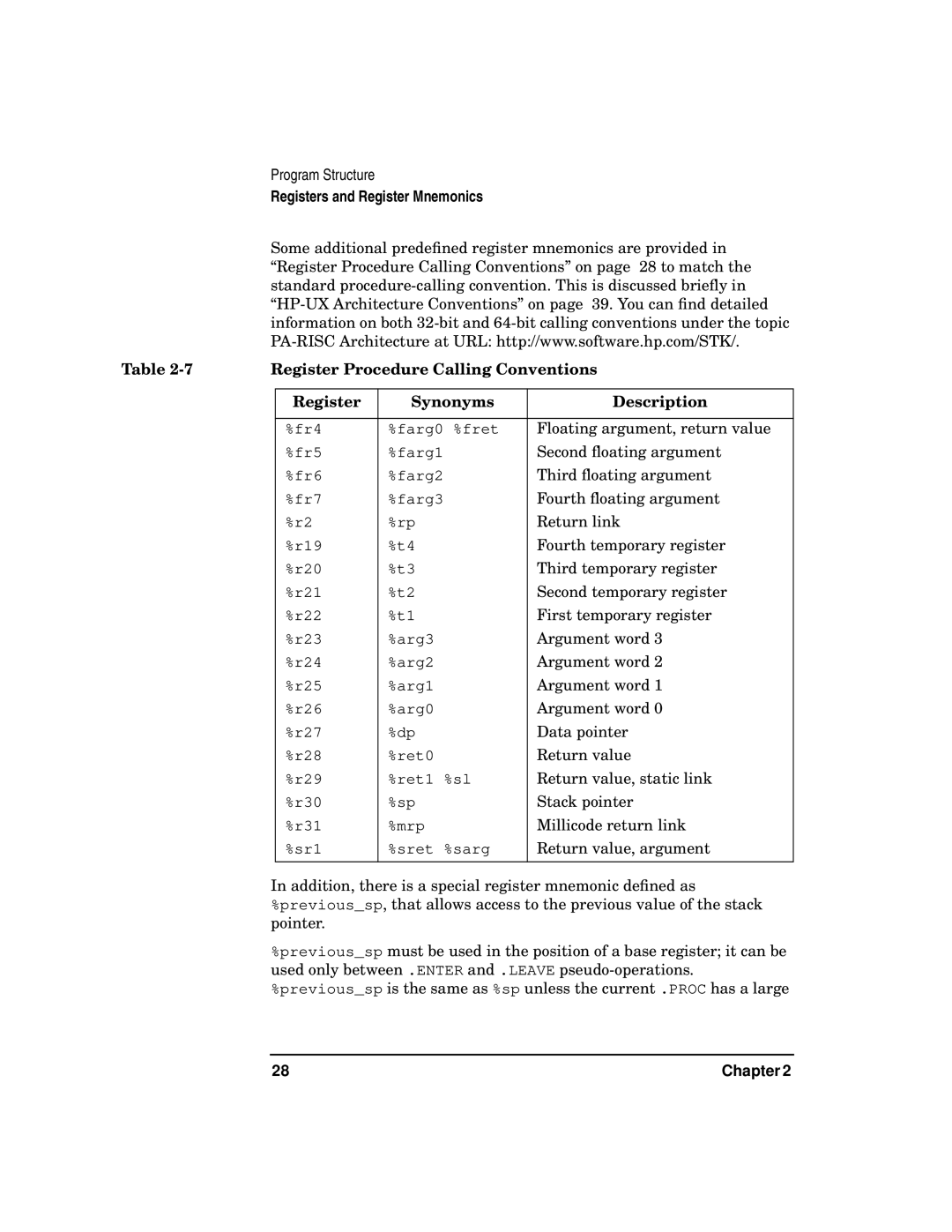HP 9000 Computers
92432-90012 June
Restricted Rights Legend
Legal Notices
Hanover Street Palo Alto, California
Contents
Assembler Directives and Pseudo-Operations
Contents
Contents
Contents
Contents
Pseudo-Instruction Set Assembling Your Program
Programming Examples
Diagnostic Messages
Index
Printing History
Preface
Edition Date Software Version
Audience
Related Documentation
Typographical Conventions
This Manual
Summary of Technical Changes for HP-UX
Assembly Language
Assembler Features
Assembler Features
Summary of Changes for PA-RISC
Summary of Changes for PA-RISC 2.0W Wide Mode, 64-bit
Summary of Changes for PA-RISC
Chapter
Summary of Changes for PA-RISC 2.0W Wide Mode, 64-bit
Program Structure
Program Structure
Label Opcode Operands Comments
Symbols and Constants
Symbols and Constants
Integer Constants Signed Unsigned
Registers and Register Mnemonics
Registers and Register Mnemonics
Registers by using an L or R suffix
General Registers
Single-Precision Floating-Point Registers
Space Registers
Double-Precision Floating-Point Registers
Control Registers Synonyms
Register Procedure Calling Conventions
Register Synonyms Description
Expressions
Expressions
Standard Arithmetic Operators
Operator Operation
Legal Combinations For Relocatable Terms Operation Result
Available Field Selectors Meaning
Field Meaning Selector
Multiple of 2048 allows a three-instruction sequence
Parenthesized Subexpressions
Operands and Completers
Operands and Completers
Addi
Defining New Instructions With Macros
Macro Processing
Macro Processing
Contains general register 19, or binary 10011. These
HP-UX Architecture Conventions
Spaces
Spaces
Memory Layout on HP-UX Sr4 Sr5 Sr6
Attributes
Subspaces
Subspaces
Standard Subspaces and Sort Keys
Directives
Space Subspace Sort Key Use
Sections in 64-bit Mode
Sections in 64-bit Mode
$INIT$
Location Counters
Location Counters
Compiler Conventions
Compiler Conventions
Compiler Conventions
Global Symbol Usage
Mfctl
Shared Libraries
Assembly Listing
Shared Libraries
Assembly Listing
Assembler Directives
Introduction
Directive Function
Requests common storage for a specified number Bytes
Pseudo-Operations Directive Function
Reserves 16 bits a half word of storage
Align Directive
Syntax
Parameters
Example
Discussion
Allow Directive
Allow Directive
To the .LEVEL specified for the file
Block and .BLOCKZ Pseudo-Operations
Block and .BLOCKZ Pseudo-Operations
Space $TEXT$ Subspa $CODE$ Block
Byte Pseudo-Operation
Byte Pseudo-Operation
Byte initvalue , initvalue
Call Directive
Call Directive
Call argumentdescription argumentdescription
Form of argument-description is Arg=location Where arg can
Return value for a procedure
first word in the argument list
Second word in the argument list
LIT Align Word
Procend Export
Callinfo Directive
Callinfo Directive
Callinfo parameter , parameter
Register
ENTRYSR=
Unwound
It restores the RP value when it encounters a .LEAVE
Callinfo Directive Stack Frames
Re-enter code subspace
Comm Directive
Comm Directive
Label .COMM numbytes
Label Labels the location of the reserved storage
Copyright Directive
Copyright Directive
Company-name
Proc Callinfo Enter
Integer .fraction E power
Fraction E power
Double Pseudo-Operation
Double Pseudo-Operation
Dword Pseudo-Operation
Dword Pseudo-Operation
Dword initvalue , initvalue
END Directive
END Directive
Endm Directive
Endm Directive
Enter and .LEAVE Pseudo-Operations
Enter and .LEAVE Pseudo-Operations
Space $TEXT$
Entry and .EXIT Directives
Entry and .EXIT Directives
Symbolicname .EQU value
EQU Directive
EQU Directive
Value
Export Directive
Export Directive
Argument
Export proc,ENTRY,ARGW0=GR
Float Pseudo-Operation
Float Pseudo-Operation
Half Pseudo-Operation
Half Pseudo-Operation
Half initvalue , initvalue
Import Directive
Import Directive
NOP END
Label Directive
Label Directive
Label labelid
Labelid Names the label identifier
Level Directive
Level Directive
Level Directive
Listoff and .LISTON Directives
Listoff and .LISTON Directives
Liston Code Space $TEXT$ SPNUM=0,SORT=0 Subspa $CODE$
Locct Directive
Locct Directive
Macro Directive
Macro Directive
Label .MACRO formalparameter,formalparameter
Examples
100
Origin Directive
Origin Directive
Chapter 101
Proc and .PROCEND Directives
Proc and .PROCEND Directives
102
Chapter 103
REG Directive
REG Directive
Label .REG typedregister
Label User-defined register name
Shlibversion Directive
Shlibversion Directive
Chapter 105
Space Directive
Space Directive
106
Chapter 107
Spnum Pseudo-Operation
Spnum Pseudo-Operation
108
String and .STRINGZ Pseudo-Operations
String and .STRINGZ Pseudo-Operations
Chapter 109
110
Subspa Directive
Subspa Directive
Name An identifier that names the current subspace
Chapter 111
112
Chapter 113
Version Directive
Version Directive
114
Word Pseudo-Operation
Word Pseudo-Operation
Word initvalue , initvalue
Chapter 115
Directive Space Name Default Parameters
Programming Aids
Programming Aids
Predefined Subspace Directives
Shortdata
Chapter 117
Programming Aids 118
Pseudo-Instruction Set
119
120
Cond Description
Compare and Branch Conditions Comb and Comib
Chapter 121
Add and Branch Conditions Addb and Addib Description
122
Invoking the Assembler
123
Using the as Command
Using the as Command
Assemble code for the architecture
124
Level
filename
Chapter 125
Wnumber
Tables, see HP-UX Linker and Libraries
Online User Guide
126
Using the cc Command
Using the cc Command
Passing Arguments to the Assembler
Wa, ,as-argument as-argument
Cpp Preprocessor
128
Programming Examples
129
Binary Search for Highest Bit Position
Binary Search for Highest Bit Position
130
Chapter 131
Copying a String
Copying a String
132
Chapter 133
Dividing a Double-Word Dividend
Dividing a Double-Word Dividend
134
Programming Examples
Chapter 135
Demonstrating the Procedure Calling Convention
Demonstrating the Procedure Calling Convention
Program Listing
136
Assembly Program Listing
Chapter 137
Output of the cc -S Command
Assembly Program Listing From the C Compiler
Output of the cc -S Command
138
Chapter 139
Output of the cc -S Command 140
141
Option operand
142
Chapter 143
Reserve
144
Use a general register
Wrong register type used
Chapter 145
Use a control register
Use a space register
146
Chapter 147
148
Chapter 149
150
Chapter 151
Used to invoke the assembler
152
Chapter 153
Error Messages
Error Messages
154
Chapter 155
156
Chapter 157
158
1027
1028
1029
1030
1031
1032
1033
1034
1035
1036
1037
1038
162
Chapter 163
1054
1055
1056
1057
Chapter 165
166
Chapter 167
168
Format keyword=value
1080
1081
1082
170
1088
1089
1090
Chapter 171
1091
1094
1095
1096
1097
1098
1099
1100
1101
1102
1103
1104
1105
Chapter 175
Panic Messages
Panic Messages
176
2005
2006
2007
2008
User Warning Messages
User Warning Messages
178
7003
7004
7005
7006
180
Chapter 181
182
Limit Error Messages
Limit Error Messages
7200
7201
7202
7203
7204
184
Diagnostic Messages
Chapter 185
186
Branching Error Messages
Branching Error Messages
Chapter 187
188
Chapter 189
190
Chapter 191
192
7827
7828
7834
7835
7836
7837
Expr
194
Index
Index 195
196
Numerics
Index 197
Copyright
198
HP C/HP-UX,49
Index 199
Mfctl
200
Double
Index 201
See also memory
202

